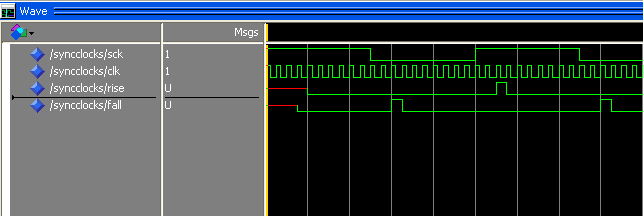I am a newbie in digital logic design and I'm trying to get my head around syncing external signals to the global clock in an FPGA. For example, the SCK signal/clock fed to an FPGA by the SPI Master. I understand this can be done as follows in VHDL (code taken from http://www.doulos.com/)
entity SyncClocks is
port( SCK : in std_logic;
CLK : in std_logic;
rise : out std_logic;
fall : out std_logic);
end SyncClocks;
architecture RTL of SyncClocks is
begin
sync1: process(CLK)
variable resync : std_logic_vector(1 to 3);
begin
if rising_edge(CLK) then
rise <= resync(2) and not resync(3);
fall <= resync(3) and not resync(2);
resync := SCK & resync(1 to 2);
end if;
end process;
end architecture;
Simulating the above results in:

Now I know why the Rise/Fall signals are delayed by two clocks - it's because SCK goes through two flip-flops. I've also been told that it's better to act on these rise and fall signals than on the SCK signal itself. My question is doesn't this two-clock delay actually affect how the data is transferred? Let's suppose I have a microcontroller acting as SPI Master and talking to my FPGA, which is a SPI Slave. They are operating in SPI Mode 0. Furthermore, let's assume the FPGA needs to transfer some data to the microcontroller.
As soon as SS goes low the microcontroller will expect a bit to be present on the MISO line which it will sample on the rising edge of SCK. When SCK falls the FPGA has to shift out another bit onto the MISO line - but the FPGA waits two clock cycles because of our sync. and edge detection. In other words, it won't actually shift out on the falling edge of SCK it will shift out when the signal "Fall" is '1' in the above example.
Will this not cause problems on the microcontroller end? Obviously the microcontroller has no knowledge of Rise/Fall and it's clock may be running completely independently at a different frequency.
I have been trying to think this through and it seems to me that the problem will not occur if the SCK signal is slow compared to the global clock. This is because even though there is a delay it doesn't matter because the FPGA will shift out a bit 'quick enough' anyway i.e. before SCK rises. How wrong am I?
